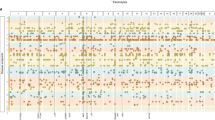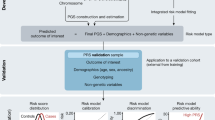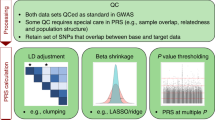Abstract
Introduction:
The PhenX Toolkit, an online resource of well-established measures of phenotypes and exposures, now has 16 new measures recommended for assessing rare genetic conditions.
Materials and Methods:
These measures and their protocols were selected by a working group of domain experts with input from the scientific community.
Results:
The measures, which cover life stages from birth through adulthood, include clinical scales, characterization of rare genetic conditions, bioassays, and questionnaires. Most are broadly applicable to rare genetic conditions (e.g., family history, growth charts, bone age, and body proportions). Some protocols (e.g., sweat chloride test) target specific conditions.
Discussion:
The rare genetic condition measures complement the existing measures in the PhenX Toolkit that cover anthropometrics, demographics, mental health, and reproductive history. They are directed at research pertaining to common and complex diseases. PhenX measures are publicly available and are recommended to help standardize assessments across a range of biomedical study designs. To facilitate incorporation of measures into human subjects’ research, the Toolkit offers data collection worksheets and compatible data dictionaries.
Conclusion:
Widespread use of standard PhenX measures in clinical, translational, and epidemiological research will enable more uniform cross-study comparisons and increase statistical power with the potential for enhancing scientific discovery.
Genet Med advance online publication 12 January 2017
Similar content being viewed by others
Main
PhenX uses a consensus-based process to identify measures of phenotypes and exposures for biomedical studies. Funded by the National Human Genome Research Institute and the National Institute on Drug Abuse, with supplemental funding from other National Institutes of Health (NIH) institutes for specific research areas or conditions (e.g., mental health, sickle cell disease, tobacco regulatory research, and substance use), the PhenX Toolkit is a Web-based catalog that includes more than 450 measures that broadly address 23 research domains and add depth to four research areas. As of 5 May 2016, the PhenX Toolkit had been recommended in 166 NIH funding opportunity announcements. Measures in the PhenX Toolkit are publicly available at http://www.phenxtoolkit.org.
Originally, when the PhenX Toolkit was made available in 2008, it was mainly a resource for genome-wide association studies; however, with the addition of research domains and more specific disciplines it expanded to epidemiological and biomedical research. The PhenX Toolkit is ideal for investigators who want to expand their disease-specific studies into disciplines outside the focus of their research. This gives investigators without expertise in these disciplines an opportunity to incorporate high-quality measures into their studies at the study design stage.1
The PhenX steering committee (SC), which consists of 10 researchers recommended because of their broad genetic, epidemiology, and biomedical research expertise, provides guidance to the project.2 In 2013, the SC decided that the field of genetics would benefit from a set of standard measures to encourage research in rare (i.e., very-low-prevalence) diseases and syndromes.3 This paper describes the process of selecting the measures in the Rare Genetic Conditions domain, details the measures selected for inclusion in the PhenX Toolkit, and describes the challenges in identifying these measures. Investigators are encouraged to utilize this carefully selected set of standard measures in a wide variety of study designs.
Methods
The PhenX Rare Genetic Conditions Working Group (WG) consisted of medical and clinical geneticists, including three physicians, a pediatrician, a certified genetic counselor, an epidemiologist, a registered nurse, and a patient advocate, and was supported by an SC liaison and staff from RTI International. The WG was charged with identifying up to 15 high-priority measures to assess rare genetic conditions, the scope of which included organ systems, family health history, and genetic mutations. The WG used the definition of a rare disease enacted by the Orphan Drug Act of 1983—having a prevalence of fewer than 200,000 affected individuals in the United States—and focused on rare conditions that have a known genetic component.4
Each WG member was assigned one or more scope elements and reviewed the existing relevant Toolkit measures and protocols, appropriate literature, and current clinical and research tools used for data collection to recommend measures and protocols to vet. Most of the WG review occurred during a 1-day in-person meeting; additional discussions were accomplished via teleconferences. All of this occurred over an 8-month time period in 2014–2015 and resulted in the WG achieving a consensus regarding 16 measures after identifying and vetting a total of 51 measures. The WG used the SC criteria (e.g., clearly defined, well-established, reproducible, low burden, used in a major study) for this selection and were mindful of the need to complement existing PhenX Toolkit content.
Results
Sixteen new measures (see Table 1 ) were added to the PhenX Toolkit in April 2015 (see https://www.phenxtoolkit.org/index.php?pageLink=browse.measures&id=220000). Most measures (e.g., family history, growth charts, bone age, and body proportions) are broadly applicable to rare genetic conditions research. Measures were not identified and subsequently were not recommended for each organ system because standardized protocols are not available (e.g., skin conditions) or tools for those phenotypes were already covered by existing Toolkit measures (e.g., ocular). Ideally, PhenX measures include nonproprietary protocols, but two proprietary protocols—the Disability Index and the Scale of Developmental Domains of Early Childhood—were included in this domain because they were the most commonly used. Owing to the complexity of assessing rare genetic condition phenotypes, nine of these are considered high-burden measures (e.g., two require specialized training, two take more than 15 minutes to administer to an unaffected individual, and five require both training and more time). Details regarding the burden appear in the Requirements section for each protocol.
Guidelines from the Human Genome Variation Society (HGVS), which were used to properly name genetic variants, were added as Supplemental Information (SI) as an additional resource for researchers. Although highly relevant to rare genetic condition research, the guidelines were not a standardized protocol and did not meet the SC selection criteria for inclusion in the Toolkit.
To illustrate the content of the Toolkit, three of the rare-genetic-condition measures are described below.
Family health history
A multigenerational pedigree is the gold standard for family health history. Many pedigrees are proprietary instruments. The WG selected the US Surgeon General’s Web-based tool My Family Health Portrait (http://www.familyhistory.hhs.gov/FHH/html/index.html). It is nonproprietary and customizable and captures an individual’s family health history through structured and open-ended questions. My Family Health Portrait is widely used; the website was accessed more than 1.7 million times between 2011 and September 2015 (S. Pandya, personal communication, 27 October 2015).
Growth charts
Abnormal growth is a feature of many rare genetic conditions, including Turner syndrome, Marfan syndrome, Noonan syndrome, and various forms of skeletal dysplasia. Growth charts provide information regarding deviations from typical growth patterns. This information, along with other clinical and laboratory findings, can assist investigators with their research. The World Health Organization and the Centers for Disease Control and Prevention growth charts were selected for the Growth Charts measure because they are the most common standard methods used in clinical and research practice to record growth.5,6
Ataxia rating scale
Ataxia is a symptom of several rare neurologic conditions, including ataxia telangiectasia and the various forms of spinocerebellar ataxia (SCA). Because disorders that affect the cerebellum cause most genetic forms of ataxia, ataxia rating scales are used to assess the severity of cerebellar ataxia. The Scale for the Assessment and Rating of Ataxia (SARA) was selected because it has good metric properties and interrater reliability and is easily administered.7 The validation procedures for the SARA involved three large multicenter trials including patients with SCA and non-SCA ataxia as well as controls. The SARA has been shown to be a reliable and valid scale for measuring ataxia, with scores that correlate closely with other scales of ataxia as well as with activities of daily living.
Discussion
Clinicians and researchers may wish to seriously consider incorporating PhenX measures into their own practice and research efforts because meta-analyses with the standardized measures could lead to genetic discoveries. Because the PhenX Toolkit resource facilitates cross-study analyses, the measures should be of particular interest to rare-condition researchers because of the limited sample size in each trial or study. In addition, these approaches may expand the existing understanding of some genetic conditions and lead to improved services and health for those with these conditions.
The rare-genetic-condition measures can be accessed by users with varying levels of experience with rare genetic conditions. For instance, protocols are applicable to study designs that include individuals who have already been diagnosed or are being evaluated, or both. As a result, they are beneficial to researchers who have experience with a specific rare condition, such as cystic fibrosis, as well as researchers who work with diseases for which a diagnosis is elusive.
Along with the research benefits to investigators of the rare-genetic-condition measures, there are limitations. For instance, the WG could not identify standard low-burden measures for certain organ or sensory systems, such as gastrointestinal, ocular, and auditory systems. Another challenge was identifying a standard measure for newborn screening. Although each state conducts such screening, the conditions for which each state screens vary, as do their cutoffs for what constitutes disease. As a result, there was no WG consensus on a measure for newborn screening so it was not included in the Toolkit. Similarly, no standard screening panel for rare metabolic genetic conditions was identified. Instead, health-care providers base their laboratory-test orders on an individual’s clinical evaluation and family history. Therefore, the WG did not include a measure for a metabolic screening panel.
In addition to the measures in the Rare Genetics Conditions domain, other measures and resources in the Toolkit are relevant to research in both common and rare genetic conditions. A collection of measures for sickle cell disease research was added to the Toolkit in July 2015. In addition, the Genetic Alliance (http://www.geneticalliance.org) led a crowd-sourcing effort to annotate PhenX measures for specific genetic conditions. Researchers are encouraged to use this tool to annotate protocols for other rare genetic conditions. For example, the Exercise Capacity/Six-Minute Walk Test is used to measure the response to medical interventions in patients with moderate to severe heart or lung disease, and it is used as an outcome measure for people with Duchenne muscular dystrophy.8 The annotation tool is available on the Resources tab of the PhenX Toolkit.
The Toolkit has several features that make it a user-friendly resource. Investigators can use the search function to find measures of interest and then add them to their personalized Toolkit to be downloaded as needed. In addition to the measures, data-collection worksheets and data dictionaries are available for each measure; these can be easily downloaded via the “My Toolkit” feature, which functions similarly to an online retailer’s shopping cart. Investigators who become registered users of the PhenX Toolkit may save their work, share measures with colleagues, and receive updates about changes to the Toolkit. PhenX protocols are now available as “instrument zip” files on the Research Electronic Data Capture (REDCap) Shared Library website (https://redcap.vanderbilt.edu/consortium/library/search.php), making it easy for investigators to include PhenX measures in REDCap study designs.
Conclusion
Researchers of rare genetic conditions are encouraged to use the PhenX Toolkit when designing studies or adding measures to their research protocols. The use of standard measures facilitates cross-study analysis with limited sample sizes. The Toolkit gives investigators the capacity to expand original research and to look at common risk factors and overlapping phenotypes across rare genetic conditions and common and complex diseases.
Disclosure
The authors declare no conflict of interest.
References
Hamilton CM, Strader LC, Pratt JG, et al. The PhenX Toolkit: get the most from your measures. Am J Epidemiol 2011;174:253–260.
Maiese DR, Hendershot TP, Strader LC, et al. PhenX—establishing a consensus process to select common measures for collaborative research. RTI Press Publication MR-0027-1310. RTI Press: Research Triangle Park, NC, 2013.
de la Paz MP, Villaverde-Hueso A, Alonso V, János S, Zurriaga O, Pollán M, et al. (2010). Rare diseases epidemiology research. Adv Exp Med Bio, 686:17–39.
Orphan Drug Act, Pub. L. No 97–414, 96 Stat. 2049 (1984 as amended).
Centers for Disease Control and Prevention. National Center for Health Statistics. Growth Charts. 2010. http://www.cdc.gov/growthcharts/. Accessed 25 July 2016.
World Health Organization. The WHO Child Growth Standards. 2016. http://www.who.int/childgrowth/en/. Accessed 25 July 2016.
Schmitz-Hübsch T, du Montcel ST, Baliko L, et al. Scale for the assessment and rating of ataxia: development of a new clinical scale. Neurology 2006;66:1717–1720.
McDonald CM, Henricson EK, Abresch RT, et al.; PTC124-GD-007-DMD Study Group. The 6-minute walk test and other endpoints in Duchenne muscular dystrophy: longitudinal natural history observations over 48 weeks from a multicenter study. Muscle Nerve 2013;48:343–356.
Lifshitz F (ed). Pediatric Endocrinology, 5th edn, vol. Pediatric Endocrinology: Growth, Adrenal, Sexual, Thyroid, Calcium, and Fluid Balance Disorders. Informa Healthcare USA: New York, 2007.
Lohman TG, Roche AF, Martorell R (eds). Anthropometric Standardization Reference Manual. Human Kinetics: Champaign, IL, 1988.
Centers for Disease Control and Prevention. National Health and Nutrition Examination Survey 2007–2008 Anthropometry Procedures Manual. 2007. http://www.cdc.gov/nchs/data/nhanes/nhanes_07_08/manual_an.pdf. Accessed 25 July 2016.
Westat. National Health and Nutrition Examination Survey III: body measurements (anthropometry). Prepared for the Centers for Disease Control and Prevention. 1988. http://www.cdc.gov/nchs/data/nhanes/nhanes3/cdrom/nchs/manuals/anthro.pdf. Accessed 25 July 2016.
Broder HL, Wilson-Genderson M, Sischo L. Reliability and validity testing for the Child Oral Health Impact Profile-Reduced (COHIP-SF 19). J Public Health Dent 2012;72:302–312.
Centers for Disease Control and Prevention. National Center for Health Statistics. Complete blood count. In: Laboratory Procedures Manual. US Department of Health and Human Services, Centers for Disease Control and Prevention: Hyattsville, MD, 2010:7-3–7-30.
Weese-Mayer DE, Berry-Kravis EM, Ceccherini I, Keens TG, Loghmanee DA, Trang H ; ATS Congenital Central Hypoventilation Syndrome Subcommittee. An official ATS clinical policy statement: Congenital central hypoventilation syndrome: genetic basis, diagnosis, and management. Am J Respir Crit Care Med 2010;181:626–644.
Clinical and Laboratory Standards Institute. Sweat Testing: Sample Collection and Quantitative Chloride Analysis: Approved Guideline, 3rd edn. CLSI document C34-A3. Clinical and Laboratory Standards Institute: Wayne, PA, 2009.
LeGrys VA, Yankaskas JR, Quittell LM, Marshall BC, Mogayzel PJ Jr ; Cystic Fibrosis Foundation. Diagnostic sweat testing: the Cystic Fibrosis Foundation guidelines. J Pediatr 2007;151:85–89.
Wildeman M, van Ophuizen E, den Dunnen JT, Taschner PE . Improving sequence variant descriptions in mutation databases and literature using the Mutalyzer sequence variation nomenclature checker. Hum Mutat 2008; 29:6–13.
Acknowledgements
The PhenX team thanks Erin Ramos, the NHGRI Project Officer, and the members of the Rare Genetic Conditions Working Group, including Peter Byers (chair), Lisa Heral, Janine Lewis, Cynthia Powell, and Sarah Soden. We are also grateful to the Genetic Alliance for their assistance with the PhenX Annotation Tool. Funding was provided by a Genomic Resource Grant (U41 HG007050) from NHGRI, with cofunding from NIDA.
The findings and conclusions in this article are those of the authors and do not necessarily represent the official position of the Centers for Disease Control and Prevention and the National Institutes of Health.
Author information
Authors and Affiliations
Corresponding author
Rights and permissions
About this article
Cite this article
Phillips, M., Grant, T., Giampietro, P. et al. PhenX measures for phenotyping rare genetic conditions. Genet Med 19, 834–837 (2017). https://doi.org/10.1038/gim.2016.199
Received:
Accepted:
Published:
Issue Date:
DOI: https://doi.org/10.1038/gim.2016.199



